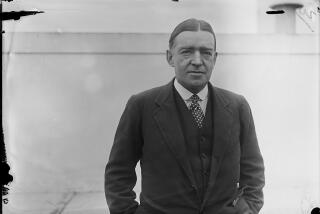Historic Ships Left to Sail Into a Grim Sunset
- Share via
WISCASSET, Maine — The remains of the historic Hesper and Luther Little schooners are heaped high in a landfill--out of sight, out of mind, awaiting their final fate.
Their unfitting predicament is a far cry from when they were the most visible ships in the state, their presence as a Maine landmark rivaling that of the L.L. Bean store 15 miles away in Freeport.
For 67 years, the Hesper and Luther Little sat grounded on the bottom of the Sheepscot River, barely a stone’s throw from busy Route 1 where tens of millions of cars passed them by over the decades. Little by little the schooners deteriorated, until the town was forced to haul them out of the river and dump them unceremoniously into a landfill.
The town is now under pressure to decide what to do with the remains of the four-masted ships. When that is determined, it will mark the final chapter of a highly visible part of Maine’s storied maritime history.
The schooners, built in Massachusetts in 1917 and 1918, were among the last four-masters ever built. Some people claim they are the most photographed ships in the world because of their proximity to busy Route 1.
Given all that, Ben Rines Jr. wasn’t too surprised when more than 325 vehicles, some from as far away as New Jersey, showed up when the town allowed souvenir seekers to rummage through the rubble over two weekends earlier this summer. The town plans to open up the site again this fall.
Whether in search of treasures or memories, what they found was a gnarly mass of wood, planks, nails, spikes and cables. Enough to fill 300-plus dump trucks. Enough to fill an area larger than a football field. Materials that reached 20 feet high in places.
“There’s a lot of maritime history here,” Rines, the town’s first selectman, said as he surveyed the pile. “Even though this is just a pile of rubble, there’s still a lot of interest in the ships.”
The schooners have been a part of Wiscasset since 1932 when Frank Winter brought them up the Sheepscot River after buying them at auction for $600 each. He intended to use them to ship lumber to Boston and bring coal to Maine.
But the plans never materialized, and the 210-foot Hesper and the 204-foot Luther Little instead sat in the mud for decades, victimized by weather, vandals and fires. In time they became part of Wiscasset’s identity; they are even depicted on the town’s police uniforms and police car doors.
They also became an indelible part of the Maine coast. People driving by would spot the vessels and romanticize about shipwrecks --most of them not knowing that the ships were actually abandoned and left to rot in the public eye.
By the early 1990s the vessels were in disrepair, and in 1998 the town spent $70,000 to move them to an old landfill.
The Maine Department of Environmental Protection ordered the town in April to move what is left of the ships from the landfill. While considering what to do, the town opened up the site to help ease the burden and give people a final chance to collect memorabilia.
The owners of Sarah’s Cafe plan to use some of the wood to frame a wall mural of the schooners.
Debbie Pendleton, who operates a small gift shop on the Wiscasset waterfront, will sell splinters from the ships in souvenir jars that will also include clamshells, pine cones and other items.
“We’ll also be there to console the public that we let the ships rot out from under us,” Pendleton said.
More to Read
Sign up for Essential California
The most important California stories and recommendations in your inbox every morning.
You may occasionally receive promotional content from the Los Angeles Times.













